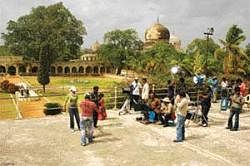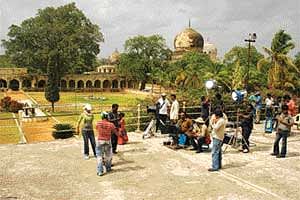

The Telugu entertainer is not amused. The second largest film industry after Bollywood, the Telugu film industry or Tollywood as it has been dubbed, is facing a crisis that has been partly of its own making and partly by others. The film producers have taken a hit after hit while a box office hit has missed them for a at least three years now. The production costs soared even as audiences disappeared from the theatres. If the Telangana movement for separate statehood disrupted the film-crazy Telugu fan's regular trips to the movie hall for several months from last December onwards, the slump in real estate market and global recession impacted the industry. The IPL-3 lasting 45 days brought the industry to its last gasp as losses soared, foretelling the imminent collapse of the industry.
After several weeks of soul-searching, the producers Telugu Film Producers' Council (TFPC) decided upon several cost-cutting measures which put them on a collision course with the artistes.
According to leading producer-director Tammareddy Bharadwaja, the major factor responsible for rising production costs is the remuneration of big stars and top technicians. "The production costs are going upwards for the past three years. And the remuneration of leading stars and heroines have become the major components of the production budgets," he said. Tollywood, which churns out around 180 movies a year, has been going through a rough patch, according to industry sources, with as almost 90 per cent failing to ring in cash boxes, leaving the producers in the lurch.
The TFPC issued an ultimatum to artistes including actors, actresses, comedians and directors to cut down their remuneration by at least 30 per cent, failing which they would stop production of films for the next six months. The film stars, particularly the 'heroes' call the shots demanding huge sums. This has led to similar demands made by others too including comedians and directors. In fact, a character actor even has a price fixed for delivering dialogues in the Rayalaseema lingo. The remuneration of a character actor like Prakash Rai's is as much as a hero's.
The reigning stars of Telugu cinema such as Venkatesh, Nagarjuna, Pawan Kalyan, Balakrishna and Junior NTR command a price ranging from Rs three crore to Rs seven crore per film. Directors like Rajamouli of "Magadheera", V.V. Vinayak of "Simhadri" and Puri Jagannadh of "Pokiri" fame charge between Rs.3-5 crore per film. As T. Prasanna Kumar, secretary of TFPC said, "Today, the average cost of Telugu films with a popular hero has skyrocketed, costing any where between Rs.25 crores to Rs.30 crore. The remuneration of artists and technicians takes away more than half of the total production cost and that leaves only 50 percent for the making of the film." In this situation, even if the film becomes a big blockbuster, the producer will get very little as profit. The chances are that even if the film becomes a partial hit, he will lose his investment. Even a medium budget film costs around Rs 20 crore and most of them fail to recover the costs, let alone make a profit.
Also the refusal of stars to give dates at a stretch adds to the number of days spent on production. Besides, the chaotic production methods worsen the situation as situations/dialogues and scenes are written and improvised even as the actors are donning the make up. No producer goes to the floor with a bound script as in Hollywood, according to insiders. The trial-and-error methods result in 'over-shooting' both in terms of use of negatives and the number of production days adding to the runaway costs. The TFPC has decided not to use more than 60,000 ft and complete a film in 45 days among its austerity measures. The biggest culprit that has the producer in a pincer is that there are simply no written agreements in the industry between the producer and the rest. Every agreement is oral and worse, the film is financed by black money.
Veteran actor and President of the Movie Artists Association (MAA), Murali Mohan who has been in talks with the TFPC to decide on corrective measures, said that the Rs 700-crore industry would collapse under this burden of costs and erratic functioning. "Movies' production cost doubled in the last five years. The producer's role while making a movie has been limited to that of an investor. Everything is decided by the hero and the director putting burden on the producer," he said.
Sources said that one formula that is being proposed is that the hero or the artiste be paid a fixed remuneration as decided by the producer of the film and thereafter a certain percentage of profit, if the film does well at the box-office. Also, the payment should be made in instalments, during production, then during post-production and finally before the movie's release thereby saving producer the high interest burden. The number of shooting days which even goes up to 200-250 days due to director's tantrums, can be reduced to 45 days. Industry sources also want to take a leaf out of Kannada film industry that has banned dubbing other language films into the local language. For instance, some of the Rajnikanth-starrer dubbed films outperformed many Telugu movies leaving Telugu producers fuming.
The 60-odd guidelines for cutting costs formulated by an eight member Cost Committee of the TFPC has found favour with top actors like Chiranjeevi, Venkatesh and Balakrishna which will go a long way in bringing the rest into the loop. As C Kalyan, producer and former president of the South Indian Film Chamber of Commerce said, "New Malayalam films have been stalled for precisely the same reasons as ours. Even Tamil producers are demanding the 'stars' to take a cut. I hope Telugu actors and directors will follow them and save the industry." Indeed, churning up dreams has become a nightmare for the industry.